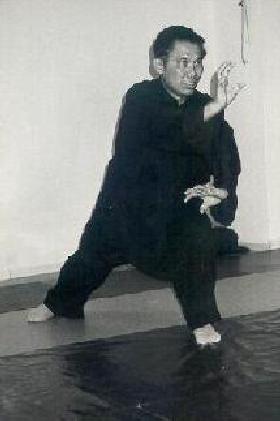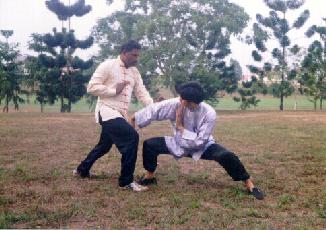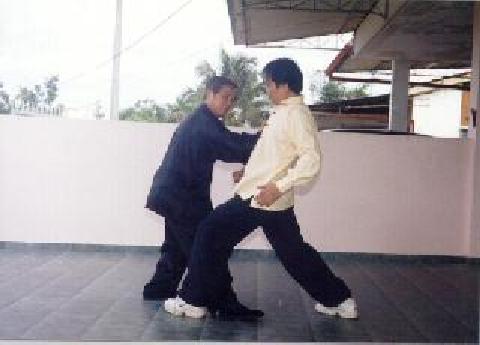April 2005 (Part 2)
SELECTION OF QUESTIONS AND ANSWERS

An old picture showing Sifu Wong demonstrating a Hoong Ka Kungfu pattern called “Hungry Tiger Catches Goat”
Question 1
Genuine martial art training, as with genuine yoga, is very hard to find.
— Terrance, England
Answer
Yes, genuine martial art, like yoga, is rare today. Strictly speaking, and this is my personal view, what many people regard as martial arts as practiced today, like Kungfu, Wushu, Karate, Taekwondo, Judo, Aikido, Boxing, Kickboxing, Muay Thai and Wrestling, are not martial arts; they are martial sports.
It was the late Don Drager, the well-known martial artist in the 1960s who highlighted this point, though he was referring more to the Japanese arts or sports. He divided them into two main categories, the “do” and the “jitsu”. Judo, Kendo and Bodo were martial sports, and they were derived from the classical martial arts of Jujitsu, Kenjitsu and Bojitsu.
Many people may accept Wushu and Kungfu as practiced today as sports because they consist of solo performance of forms without any sparring. But many people may be surprised that I refer to Karate, Taekwondo and Muay Thai as sports too. Aren't Muay Thai practitioners formidable fighters? They are. But that is a different issue. Formidable fighters may not necessarily practice martial arts, and martial artists may not necessarily be formidable fighters (though they should be).
A main reason I refer to Muay Thai as a sport is because it is mainly performed for entertainment. It is the same as Boxing in the West. Interestingly, many of those who practice Muay Thai for self defence do not realize this fact.
Secondly, as it is essential in sports, Muay Thai fighting is restricted by safety rules. If we were to take away the safety rules, Muay Thai fighting would look very different.
If it were a real fight of life and death as in the past, when a Muay Thai fighter hugged his opponent to give him continuous knee jabs, the opponent would jab a knife into the ribs of the Muay Thai fighter. If he did not have a knife at hand, he would gore out the Muay Thai fighter's genitals or eye balls. Or he might trip the Muay Thai fighter to fall and bashed the latter's skull on the floor.
A genuine martial artist will be trained to avoid getting himself into situations where such deadly attacks could happen to him. A martial sportsman is often ignorant of this important tenet in combat, because his training has been conditioned by safety rules. In the case of Muay Thai, the sportsman often gets himself into such precarious situations to give his opponent what we in Shaolin Wahnam call “free offers”.
Thirdly, a Muay Thai fighter does not know how to defend himself, or he does not bother to defend himself! This must be a big surprise to many people. Just watch a Muay Thai match. A Muay Thai fighter often lets his opponent strike his sides with knee jabs without offering any defence. Getting hurt in a match, or even in training, is taken for granted. This is ironical. In a martial art, one trains so that he will not be hurt at all.
Fourthly, a Muay Thai fighter can fight effectively only within the format of his style. If you use Judo throws or Aikido locks on him, for example, he may not know what to do because he has never been trained in his style to use these different kinds of attack and defence. A martial artist trained for real life and death fighting is different. He may not use certain forms of attack because of the preference of his style, but he is trained to handle any attacks, including against those attacks he himself may not want to use.
These four points described above apply to other martial sports too. Training in these martial sports frequently result in injuries. This is basically what should not happen in a martial art.
Please note that the issue here is not whether a martial art or a martial sport is superior or more important. To a professional Muay Thai fighter, for example, his martial sport of Muay Thai is more important than the martial art of genuine, traditional Shaolin Kungfu. He depends on Muay Thai for his living, whereas Shaolin Kungfu will only be a hobby to him.
We are also not saying that a martial artist is a better fighter than a martial sportsman. In theory a genuine, traditional kungfu exponent is a better fighter than a Muay Thai practitioner because the former has a richer variety of fighting techniques and combat principles. But in practice a professional Muay Thai fighter usually beats a kungfu exponent despite his inferior techniques because he has far better skills due to his daily training as a professional.
Question 2
I have come to the conclusion that martial art training without meditation and qi gong, is not martial art. Not only are the higher elements of self defense missing, but the internal “fight” against disease is not addressed.
Answer
What you say is true when it concerns great martial arts. But most martial arts are ordinary, not great, and therefore your conclusion may not be true.
For our purpose here, we may divide martial arts into three classes.
Third class martial arts, where most martial arts or sports of today belong to, including many styles of genuine kungfu, are solely for fighting, and their training is mainly physical, without meditation and qigong. In fact, many of their training methods, like striking their fists into tree trunks to condition them and tensing their body for muscular strength, are detrimental to health.
Second class martial arts are those that train combat efficiency as well as contribute to health. They include all internal kungfu styles like Pa Kua and Hsing Yi, some external kungfu styles like Hoong Ka and Praying Mantis, and some non-Chinese styles like Jujitsu and Aikido. With the exception of the internal styles, their training is mainly physical with occasional application of medication and qigong to enhance their training.
First class martial arts are those that train combat efficiency, contribute to health and cultivate towards the highest spiritual attainment. Without meaning disrespect to the other martial arts, I can think of only two examples, genuine traditional Shaolin Kungfu and genuine traditional Taijiquan. Here the training itself is meditation and qigong, the physical form is merely the vehicle.
In internal styles of kungfu like Pa Kua and Hsing Yi, it is also true that the training is meditation and qigong, with the physical form acting as a vehicle, though the emphasis on the physical form is relatively more. But basically these arts were first developed for fighting, whereas Shaolin Kungfu and Taijiquan developed from the original purpose of spiritual cultivation. The initial impetus and philosophy, of course, have great influence on the subsequence development and methodology of the arts.
Hence, many martial arts do not employ meditation and qigong in their training, but they are still martial arts. It is also true that these martial arts do not address the internal “fight” against diseases.
Understandably, many people may disagree with my criteria for classifying martial arts into the above three categories. They may argue that a martial art that defeats an opponent fast regardless of the cost, is first class. On the other hand, even if they agree with my classification, they can still argue that theirs are first class martial arts even when their arts are aggressive and brutal.
But I would find it hard to understand how one could still say that a certain martial art contributes to health, combat efficiency and spiritual cultivation when their practitioners routinely and intentionally hurt one another in their practice, which shows that they will not be healthy, have poor self defence and harm their spirit.
Question 3
I would very much like to hear your opinion of the Shaolin Temple in xxx. Are they teaching genuine Kung Fu? Or is it just Wushu?
Answer
To me, it is very clear that they are teaching Wushu. The hallmarks of genuine Shaolin Kungfu — internal force and combat application — are missing.
Their typical force training methods are push-ups and running, which are external. They only practice solo forms, and cannot apply their kungfu forms for combat. When they do “san shou”, which is free sparring, they use boxing and kickboxing techniques, not kungfu patterns. They do not believe that stances are effective for fighting, they bounce about like boxers.

Combat application is an essential part of genuine, traditional kungfu
Question 4
Reading through your website there is a point that came to my attention and I hope that I do not cause offense. In your questions and answers section you mention “Tajiquan masters ... fighting like animals.” I very much agree with the point you are making.
However, animals are rarely seen to fight for the sake of fighting. As they are part of the infinite wisdom and beauty of nature, they cannot afford to injure themselves in confrontations that would threaten their ability to survive. This is one of the many things humans can learn from the other “peoples” of this planet. It would perhaps be more appropriate to say that only a human accosted with his/her dis-eased mind would fight like this.
Answer
I agree with you. Only a human with a diseased mind would intentionally work himself to frenzy to fight like an animal. It is contrary to genuine Taijiquan philosophy and training.
A Taijiquan practitioner aims to be relaxed even when fighting. At the highest level, he aims to attain immortality or merge with the Tao. This is progressing from the human level to the divine or cosmic, not retrogressing to the animal.
Question 5
I have heard a bit lately about Qing Gong or “light body skill” and that people who have mastered this ability are able to jump much higher and that they can walk on sand or snow and not leave a single foot print. Are they able to do so because they are using their qi or internal force to resist the pull of gravity or are they achieving this by some other means?
— James, USA
Answer
Qing Gong, or the Art of Lightness, is real. I speak from personal experience as I had some training in this art. I could jump on the spot to a height of about five feet, but unfortunately I did not complete my training successfully. My Sigong, i.e. my sifu's sifu, could easily jump up a wall of ten feet. He could walk without any sound.
Qi, or intrinsic energy, is an important part of Qing Qong training. But whether a Qing Gong expert uses qi to resist the pull of gravity is a matter of semantics. Depending on one's interpretation, the answer can be yes or no. The answer is yes because the pull of gravity would not normally allow an adult to jump over ten feet. The answer is no because no matter how high he can jump, gravity will eventually pull him back to earth.
But Qing Qong experts usually do not know about or are bother with gravity. They train the art according to established methods. They may be unable to explain why they could jump so high or walk on sand or snow without leaving a foot print. When pressed for an answered, they may correctly say that they regulate their qi.
Question 6
I've found blood on my stool. Now I'm hoping it is just an anal fissure but I will go to a Western doctor and get some tests done to see if it's anything more serious.
— Marcus, UK
Answer
It is wise to consult a Western doctor about blood in your stool.
Unless the doctor advised you differently, blood in the stool is often not a serious health problem. If the blood is bright red, it could be a sign of piles. Practicing “Lifting the Sky” correctly can overcome the problem. If the blood is dark red, it might be your system cleansing unwanted things, like dead cells or damaged tissues, from your body, especially if you have been practicing chi kung correctly.
Whatever it is, don't worry. This does not mean you don't care. If the doctor says that your problem is serious, get a second and if needed a third professional opinion. If all of them say the same thing, you should not worry too but immediately and decisively seek treatment according to their advice.

One should not fight like an animal in Taijiquan, he can be elegant and graceful yet highly combat effective. Here Sifu Wong apply a Taijiquan pattern elegantly and gracefully against Goh Kok Hin during sparring.
Question 7
I've emailed you before asking if you thought my "master" was really a master. You did answer my question indirectly. I was practicing with this master his variation of "Lifting the Sky" and self manifested chi movement. Could my case be an internal injury?
Answer
“Lifting the Sky” and self manifested chi movement are signature exercises from our school, Shaolin Wahnam. But that does not mean these exercises are not found in other schools too.
I have received some reports that some instructors teach chi kung exercises learnt from my books. Some of these instructors may or may not have learnt from me, but they do not have my approval to teach as Shaolin Wahnam instructors. The list of Shaolin Wahnam instructors certified by me is found on this webpage List of Certified Instructors.
Without examining you in person, it is not advisable to tell whether the blood in your stool was a sign of internal injury, but it is obvious that you have not been practicing chi kung correctly. If you had, irrespective of where you learned your chi kung from, you would be telling me how relaxed and well you felt, instead of expressing worry and trepidation.
“Lifting the Sky” and self manifested chi movement are safe exercises. Yet, if they are performed wrongly, especially when a student tenses his muscles in a mistaken belief that it would increase his power or effect, these otherwise safe exercises could cause deviations, including internal injury.
Do you have sharp pain in your chest or at any internal organs? Do you feel tired or sleepy easily? If you do not have these negative symptoms, it is unlikely your case is that of internal injury. And if Western trained doctors did not see anything serious in your case, you will probably overcome your problem in a week or two by practicing “Lifting the Sky” correctly.
Question 8
I'm currently practicing “Lifting the Sky” once daily as shown in your book, “The Art of Shoalin Kung Fu”. After I have done the exercise my heart beats quite heavily and I sweat. However I experience chi flow and when I stand in the self meditation position I gently sway on the spot. Am I practicing right?
Answer
It is not accurate to tell whether you have practiced the exercise correctly by your description alone. Your heart beating heavily is usually a symptom of wrong practice. Probably you were too tensed, physically and emotionally, while performing the exercise.
Experiencing chi flow is usually a sign that the practice is correct. But if you tense your muscles or your emotions during chi flow, you may lock up the chi or cause other deviations.
There are many certified Shaolin Wahnam instructors in the United Kingdom. They are experienced teachers and have helped many students overcome even so-called incurable diseases. You should make an effort to see them.
LINKS
Selected Reading
- Video Clip: Shaolin Plume Flower Single Knife
- Video Clip: Application of Single Knife against Spear (1)
- Video Clip: Breaking Bricks with Internal Force
- Entering Tao — Jeffrey Segal
- I Could Never Pay You Enough for this Gift — Jeffrey Synder
- Is Shaolin Kungfu Too Flowery for Combat?
